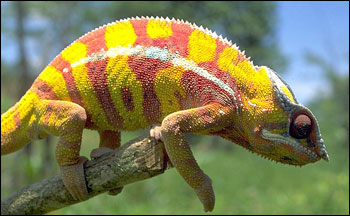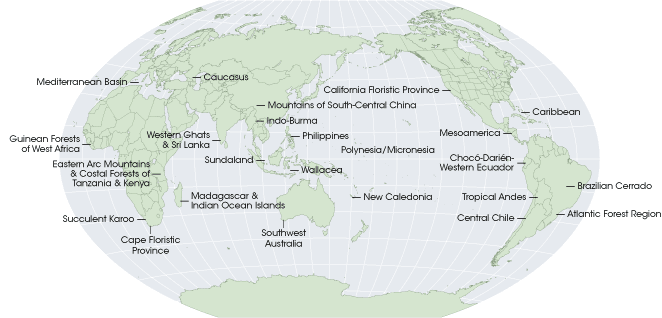

 | |||
On the island of Madagascar, off the southeast coast of Africa, NASA-funded biologist Christopher Raxworthy has stalked chameleons for the last 20 years. The most remote research camps can require nine days of bug-ridden hiking, hauling food and supplies. Most of his surveys for lizards are done at night, when chameleons sleep, and their skins turn grayish, making the hunt easier. |
|||

One big challenge for biologists like Raxworthy is that nobody knows for certain what species exist in remote areas of the tropics, and even pinpointing the best places to look for specific creatures or plants is tricky. Madagascar, for instance, is one of 25 “hotspots” around the world. Combined, these sites account for only 1.4 percent of the planet’s land area, and yet contain 44 percent of all plant species and 35 percent of all land vertebrate species. That’s a lot of diversity packed into a pretty small space, and with humans changing Earth’s land cover so rapidly, conservationists often struggle to identify biologically rich areas to protect before they are lost forever. |
Chameleons, native to the isolated island of Madagascar, are just one of the many animal and plant species that scientists are now studying with satellites. With remote sensing data, researchers are able to accurately map species’ habitats and plan conservation programs. (Photograph copyright David R. Parks, Madagascar Biodiversity and Conservation, Missouri Botanical Garden) | ||
 |
Some scientists are using remote-sensing technology to better understand relationships between species and the places they live. Satellites’ ability to routinely observe even the most remote areas can make biologists’ search for important species and habitats quicker and easier. Raxworthy, an associate curator with the American Museum of Natural History, New York, combines vast amounts of environmental information on Madagascar collected by satellites with records from museum collections that identify areas where lizards have previously been found. He feeds these data into computer models, which spit out maps showing the most likely locales for chameleons. “The most fundamental payoffs from new technologies such as satellite data are in the remote areas of the tropics,” Raxworthy says. “We can very quickly get a picture of where species might be distributed. If one were to send out survey teams alone, it might take thousands of years to generate the level of information that satellites provide.” New ToolsAs biologists, ecologists, and conservationists are under pressure to understand why and where species are being lost, satellites offer certain advantages. They regularly see vast areas of the Earth all at once, making comparisons over time possible. Also, satellites provide access to remote areas of the world, where gathering comprehensive, routinely updated data on the ground can be nearly impossible. For example, NASA’s Earth Observing System series of satellites includes satellites that monitor everything from how much of the natural landscape humans clear each year for farmland or urban growth, to the frequency and severity of air pollution events, to increased ocean temperatures in sensitive coral habitat. Along with other agencies, NASA is entering “a new age of remote sensing,” says Woody Turner, a program scientist at NASA’s Office of Earth Science. In 2003, Turner was the lead author of an article published in the scientific journal Trends in Ecology & Evolution (TREE). He and his co-authors outlined the current uses of remote sensing in biodiversity science and conservation. “We are starting to get from space a lot of parameters [characteristics about Earth] that people historically felt were important but didn’t have access to,” Turner adds. In the past, satellites have enabled researchers to see the Earth on large scales, but more recently, they provide information on smaller scales, too. In some rare cases, high resolution satellites can directly observe species on the ground. Mostly though, environmental data or images from satellites offer indirect but invaluable information about species and their habitat. Raxworthy’s experiment with chameleon habitat in Madagascar showed that satellites used in tandem with computer models allow researchers to predict the best remaining areas to protect. “Using satellite imagery is an extremely compelling way to show politicians and land managers what is going on and how land has changed,” says Ned Gardiner, one of Turner’s co-authors and a geographer and ecologist at the American Museum of Natural History in New York. “One of the most important global changes today is the decline of biodiversity,” emphasizes Turner. “It behooves us to understand what we are doing.” While data from satellites are publicly available, Turner feels that ecologists and others have been somewhat slow to catch on and start using them for conservation-related studies. |
Twenty-five locations around the world are characterized as “biodiversity hotpsots” by Conservation International. Often remote, these areas hold 44 percent of all plant species and 35 percent of all land vertebrate species in only 1.4 percent of the Earth’s landmass. (Map by Robert Simmon) |